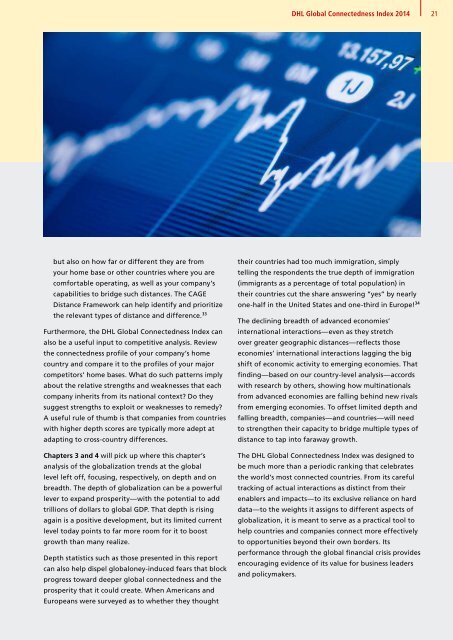DHL Global Connectedness Index 2014
DHL Global Connectedness Index 2014
DHL Global Connectedness Index 2014
- No tags were found...
You also want an ePaper? Increase the reach of your titles
YUMPU automatically turns print PDFs into web optimized ePapers that Google loves.
<strong>DHL</strong> <strong>Global</strong> <strong>Connectedness</strong> <strong>Index</strong> <strong>2014</strong><br />
21<br />
but also on how far or different they are from<br />
your home base or other countries where you are<br />
comfortable operating, as well as your company’s<br />
capabilities to bridge such distances. The CAGE<br />
Distance Framework can help identify and prioritize<br />
the relevant types of distance and difference. 33<br />
Furthermore, the <strong>DHL</strong> <strong>Global</strong> <strong>Connectedness</strong> <strong>Index</strong> can<br />
also be a useful input to competitive analysis. Review<br />
the connectedness profile of your company’s home<br />
country and compare it to the profiles of your major<br />
competitors’ home bases. What do such patterns imply<br />
about the relative strengths and weaknesses that each<br />
company inherits from its national context Do they<br />
suggest strengths to exploit or weaknesses to remedy<br />
A useful rule of thumb is that companies from countries<br />
with higher depth scores are typically more adept at<br />
adapting to cross-country differences.<br />
Chapters 3 and 4 will pick up where this chapter’s<br />
analysis of the globalization trends at the global<br />
level left off, focusing, respectively, on depth and on<br />
breadth. The depth of globalization can be a powerful<br />
lever to expand prosperity—with the potential to add<br />
trillions of dollars to global GDP. That depth is rising<br />
again is a positive development, but its limited current<br />
level today points to far more room for it to boost<br />
growth than many realize.<br />
Depth statistics such as those presented in this report<br />
can also help dispel globaloney-induced fears that block<br />
progress toward deeper global connectedness and the<br />
prosperity that it could create. When Americans and<br />
Europeans were surveyed as to whether they thought<br />
their countries had too much immigration, simply<br />
telling the respondents the true depth of immigration<br />
(immigrants as a percentage of total population) in<br />
their countries cut the share answering “yes” by nearly<br />
one-half in the United States and one-third in Europe! 34<br />
The declining breadth of advanced economies’<br />
international interactions—even as they stretch<br />
over greater geographic distances—reflects those<br />
economies’ international interactions lagging the big<br />
shift of economic activity to emerging economies. That<br />
finding—based on our country-level analysis—accords<br />
with research by others, showing how multinationals<br />
from advanced economies are falling behind new rivals<br />
from emerging economies. To offset limited depth and<br />
falling breadth, companies—and countries—will need<br />
to strengthen their capacity to bridge multiple types of<br />
distance to tap into faraway growth.<br />
The <strong>DHL</strong> <strong>Global</strong> <strong>Connectedness</strong> <strong>Index</strong> was designed to<br />
be much more than a periodic ranking that celebrates<br />
the world’s most connected countries. From its careful<br />
tracking of actual interactions as distinct from their<br />
enablers and impacts—to its exclusive reliance on hard<br />
data—to the weights it assigns to different aspects of<br />
globalization, it is meant to serve as a practical tool to<br />
help countries and companies connect more effectively<br />
to opportunities beyond their own borders. Its<br />
performance through the global financial crisis provides<br />
encouraging evidence of its value for business leaders<br />
and policymakers.





